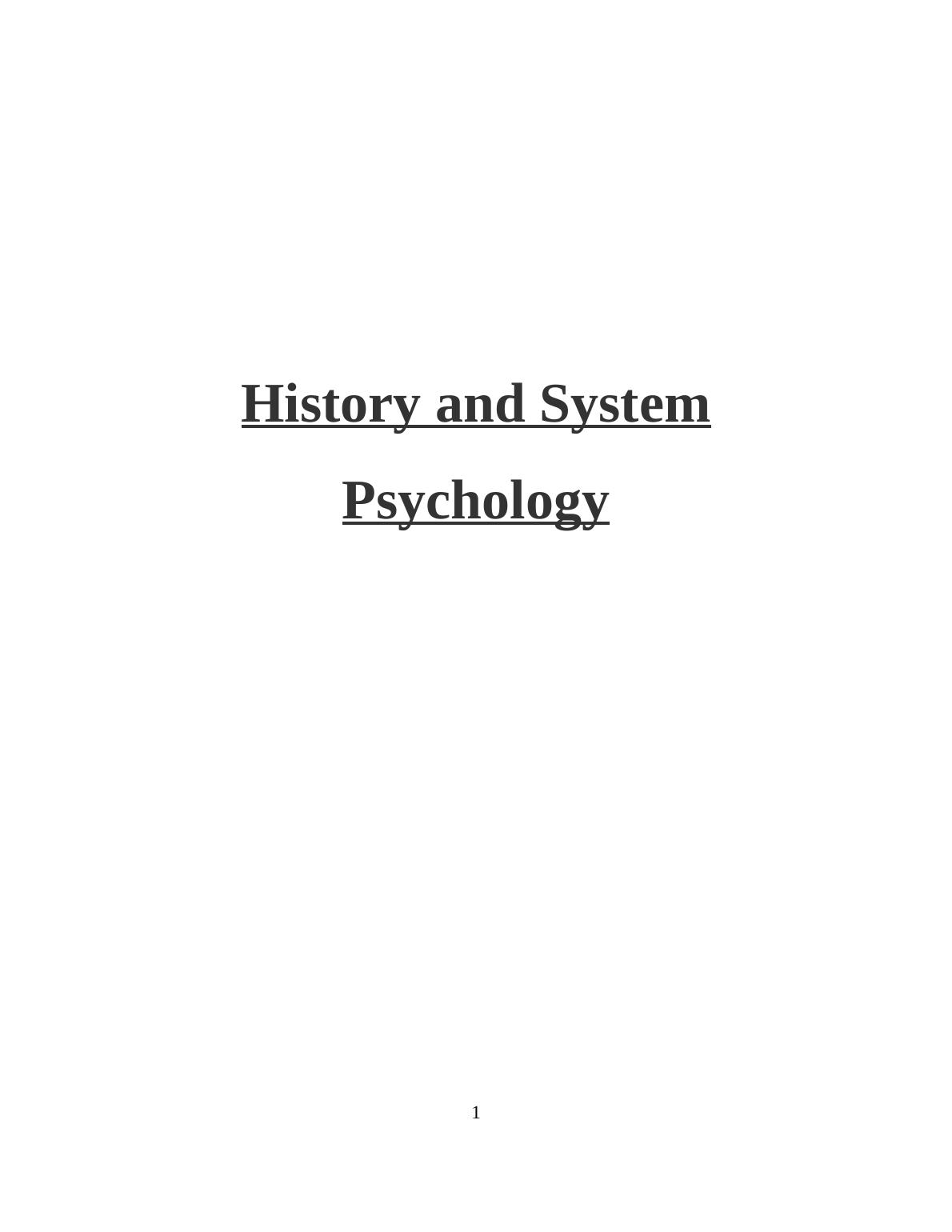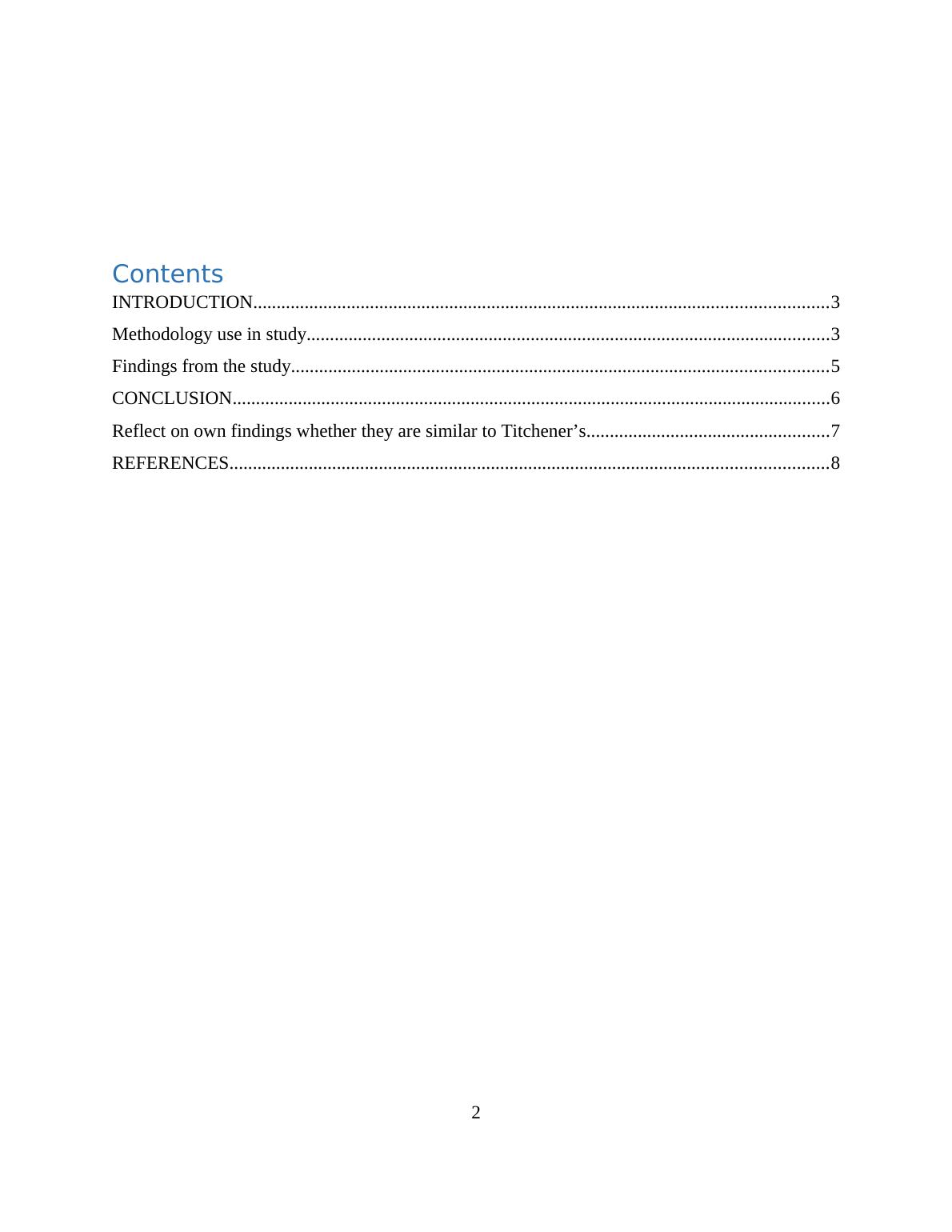Introspection in Psychology: Titchener's Findings and Mini Study
Added on 2023-01-06
8 Pages2051 Words73 Views
History and System
Psychology
1
Psychology
1

Contents
INTRODUCTION...........................................................................................................................3
Methodology use in study................................................................................................................3
Findings from the study...................................................................................................................5
CONCLUSION................................................................................................................................6
Reflect on own findings whether they are similar to Titchener’s....................................................7
REFERENCES................................................................................................................................8
2
INTRODUCTION...........................................................................................................................3
Methodology use in study................................................................................................................3
Findings from the study...................................................................................................................5
CONCLUSION................................................................................................................................6
Reflect on own findings whether they are similar to Titchener’s....................................................7
REFERENCES................................................................................................................................8
2

INTRODUCTION
Introspection is defined as an examination of an individual's own feelings and conscious
thoughts. The introspection process in psychology depends on observation of mental state of an
individual, while in spiritual context, it might have referred to one's soul examination. It is
proximally associated with self-discovery and human self-reflection and is contrasted with
extrinsic observation (Beenfeldt, (2015). Introspection can be utilised to describe a more
formalized experimental approach and an informal reflection process which was used early in the
history of psychology. It can be a good source of personal knowledge and assist people in
making connections between distinct experiences and responses. The process of introspection
gives knowledge which is not possible in other way. Edward Bradford Titchener was a
psychologist who was born on 11th January, 1867 and was a student of student of Wilhelm
Wundt. Introspection is the main tool which Titchener use for determining distinct components
of consciousness. In the Titchener’s introspective method, two types of experiences are stated,
named as dependent and independent experiences (Bitbol, & Petitmengin, (2016).
Titchener stated that individuals learn to describe the experience by utilising familiar name
instead of defining experience using stimulus. He is interested in researching human experiences
through asking people to describe their own experiences into simple definable elements. After
that, structuralists figure out the way these elements fit together to make complex experiences.
The self-observation or introspection method has been utilised as a key tool for studying the
experience of human experience in conscious stage (Brennan, & Houde, (2017). In the
introspective research of Titchener’s, three basic elements consciousness state are identified
known as affections/ feelings, images and sensations. In which, sensations are the perception
element and basis of everything, feelings and emotions elements and images are the ideas
elements which arise from the sensations that experience previously and are not present in the
current moment. The main objective of this study is to explore the elements of consciousness by
conducting a mini introspective research. The study intents to compare the Titchener's findings in
unit and reflect on it.
Methodology use in study
Unlike the Wundt introspection method, Titchener had strict guidelines for reporting
analysis of introspective. The subject will be presented with object like flower. It will then report
3
Introspection is defined as an examination of an individual's own feelings and conscious
thoughts. The introspection process in psychology depends on observation of mental state of an
individual, while in spiritual context, it might have referred to one's soul examination. It is
proximally associated with self-discovery and human self-reflection and is contrasted with
extrinsic observation (Beenfeldt, (2015). Introspection can be utilised to describe a more
formalized experimental approach and an informal reflection process which was used early in the
history of psychology. It can be a good source of personal knowledge and assist people in
making connections between distinct experiences and responses. The process of introspection
gives knowledge which is not possible in other way. Edward Bradford Titchener was a
psychologist who was born on 11th January, 1867 and was a student of student of Wilhelm
Wundt. Introspection is the main tool which Titchener use for determining distinct components
of consciousness. In the Titchener’s introspective method, two types of experiences are stated,
named as dependent and independent experiences (Bitbol, & Petitmengin, (2016).
Titchener stated that individuals learn to describe the experience by utilising familiar name
instead of defining experience using stimulus. He is interested in researching human experiences
through asking people to describe their own experiences into simple definable elements. After
that, structuralists figure out the way these elements fit together to make complex experiences.
The self-observation or introspection method has been utilised as a key tool for studying the
experience of human experience in conscious stage (Brennan, & Houde, (2017). In the
introspective research of Titchener’s, three basic elements consciousness state are identified
known as affections/ feelings, images and sensations. In which, sensations are the perception
element and basis of everything, feelings and emotions elements and images are the ideas
elements which arise from the sensations that experience previously and are not present in the
current moment. The main objective of this study is to explore the elements of consciousness by
conducting a mini introspective research. The study intents to compare the Titchener's findings in
unit and reflect on it.
Methodology use in study
Unlike the Wundt introspection method, Titchener had strict guidelines for reporting
analysis of introspective. The subject will be presented with object like flower. It will then report
3

End of preview
Want to access all the pages? Upload your documents or become a member.
Related Documents
Understanding Self and Others: Psychological Perspectives and Reflective Development Planlg...
|13
|4112
|33
Developing the Reflexive Practitioner Research Projectlg...
|12
|3800
|304
Gibbs Reflective Model Assignment (Doc)lg...
|8
|2538
|118
